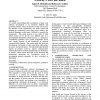Free Online Productivity Tools
i2Speak
i2Symbol
i2OCR
iTex2Img
iWeb2Print
iWeb2Shot
i2Type
iPdf2Split
iPdf2Merge
i2Bopomofo
i2Arabic
i2Style
i2Image
i2PDF
iLatex2Rtf
Sci2ools
ICSE
1999
IEEE-ACM
1999
IEEE-ACM
Splitting the Organization and Integrating the Code: Conway's Law Revisited
It is widely acknowledged that coordination of large scale software development is an extremely difficult and persistent problem. Since the structure of the code mirrors the structure of the organization, one might expect that splitting the organization across time zones, cultures, and (natural) languages would make it difficult to assemble the components. This paper presents a case study of what indeed turned out to be the most difficult part of a geographically distributed software project, i.e., integration. Coordination problems were greatly exaggerated across sites, largely because of the breakdown of informal communication channels. The results imply that multi-site development can benefit to some extent from stable plans, processes, and specifications. The inherently unpredictable aspects of projects, however, require communication channels that can be invoked spontaneously, by developers, as needed. These results shed light on the problems and mechanisms underlying the coordin...
Communication Channels | ICSE 1999 | Informal Communication Channels | Scale Software Development | Software Engineering |
| Added | 04 Aug 2010 |
| Updated | 04 Aug 2010 |
| Type | Conference |
| Year | 1999 |
| Where | ICSE |
| Authors | James D. Herbsleb, Rebecca E. Grinter |
Comments (0)

